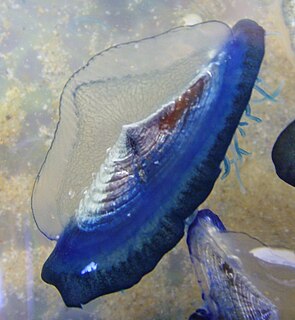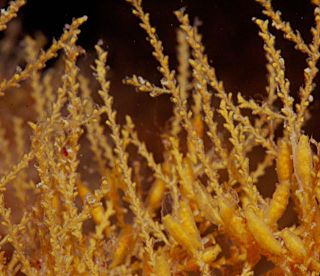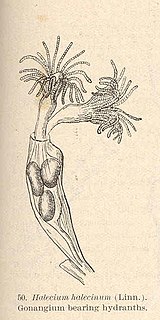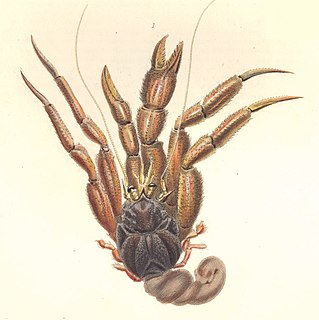
Hydrozoa are a taxonomic class of individually very small, predatory animals, some solitary and some colonial, most living in salt water. The colonies of the colonial species can be large, and in some cases the specialized individual animals cannot survive outside the colony. A few genera within this class live in fresh water. Hydrozoans are related to jellyfish and corals and belong to the phylum Cnidaria.

Velella is a monospecific genus of hydrozoa in the Porpitidae family. Its only known species is Velella velella, a cosmopolitan free-floating hydrozoan that lives on the surface of the open ocean. It is commonly known by the names sea raft, by-the-wind sailor, purple sail, little sail, or simply Velella.

Hydractinia echinata is a colonial marine hydroid which is often found growing on dead, hermit-crabbed shells of marine gastropod species. This hydroid species is also commonly known as snail fur, a name which refers to the furry appearance that the hydroids give to a shell.

Eudendrium ramosum, sometimes known as the tree hydroid, is a marine species of cnidaria, a hydroid (Hydrozoa) in the family Eudendriidae of the order Anthoathecata.

Obelia longissima is a colonial species of hydrozoan in the order Leptomedusae. Its hydroid form grows as feathery stems resembling seaweed from a basal stolon. It is found in many temperate and cold seas world-wide but is absent from the tropics.

Hydroids are a life stage for most animals of the class Hydrozoa, small predators related to jellyfish.

The grey fan hydroid is a large colonial hydroid in the family Solanderiidae.

Hydractinia altispina, or high-spined commensal hydroid, is a small colonial hydroid in the family Hydractiniidae.

Hydrocorella is a small genus of athecate hydroids in the family Hydractiniidae.

Stylaster nobilis, the noble coral, is a branching colonial hydroid in the family Stylasteridae.

Thuiaria articulata, the jointed hydroid or sea spleenwort, is a branching colonial hydroid in the family Sertulariidae.

The planar hydroid is a branching colonial hydroid in the family Sertulariidae.

Corhiza scotiae, the fine hydroid, is a delicate colonial hydroid in the family Halopterididae.

Gattya humilis, the snowdrop hydroid, is a delicate colonial hydroid in the family Halopterididae.

Pycnotheca mirabilis, The feathery hydroid, is a colonial hydroid in the family Kirchenpaueriidae. Feathery hydroids are often white and grow in crowded colonies resembling upright feathers. The stems may grow to 3 cm in total height. The reproductive bodies are found at the base of the stems and resemble beehives.

Aglaophenia pluma, the toothed feather hydroid or podded hydroid, is a colonial hydroid in the family Aglaopheniidae and is found worldwide. It lives from the shore to 120m under water.

Halecium halecinum, commonly known as the herring-bone hydroid, is a species of hydrozoan in the family Haleciidae. It is native to the eastern Atlantic Ocean, the western Atlantic Ocean and the eastern Pacific Ocean.

Labidochirus splendescens, commonly known as the splendid hermit crab, is a species of hermit crab found in the northeastern Pacific Ocean off the coast of North America. It is more heavily calcified and inhabits smaller mollusc shells than most hermit crabs.
Schuchertinia milleri, commonly known as the Miller hydractinia, hedgehog hydroid or snail fur, is a small colonial hydroid in the family Hydractiniidae, found in the eastern Pacific Ocean. It forms mat-like colonies on rocks, or sometimes on the mollusc shells occupied by hermit crabs.
Janaria is a genus of commensal athecate hydroids in the family Hydractiniidae. It is a monotypic genus and the only species is Janaria mirabilis, commonly known as staghorn hydrocoral. It is a colonial species and lives on a shell occupied by a hermit crab. It is native to the tropical and semitropical eastern Pacific Ocean.


















